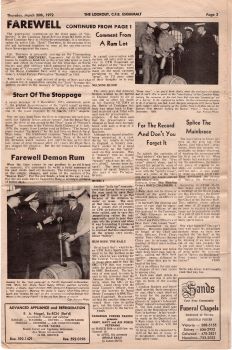|
The TOT
A Brief History of the Tot
In the 17th century the daily drink ration for English sailors was a gallon of beer. Due to the difficulty in storing the large quantities of liquid that this required in 1655 a half pint of rum was made equivalent and became preferred to beer. Over time drunkenness on board naval vessels increasingly became a problem and the ration was formalized in naval regulations by Admiral Edward Vernon in 1740 and ordered to be mixed with water in a 4:1 water to rum ratio and split into two servings per day.
In the 19th century there was a change in the attitude towards alcohol due to continued discipline problems in the navy and in 1824 the size of the tot was halved to a quarter pint in an effort to improve the situation. In 1850 the Admiralty's Grog Committee, convened to look into the issues surrounding the rum ration, recommended that it be eliminated completely. However rather than ending it the navy further halved it to an eighth of a pint per day, eliminating the evening serving of the ration. This led to the ending of the ration for officers in 1881 and warrant officers in 1918.
On December 17, 1969 the Admiralty Board issued a written answer to a question from the MP for Woolwich East, Christopher Mayhew saying "The Admiralty Board concludes that the rum issue is no longer compatible with the high standards of efficiency required now that the individual's tasks in ships are concerned with complex, and often delicate, machinery and systems on the correct functioning of which people's lives may depend". This led to a debate in the House of Commons on the evening of January 28, 1970, now referred to as the 'Great Rum Debate', started by James Wellbeloved, MP for Erith and Crayford, who believed that the ration should not be removed. The debate lasted an hour and 15 minutes and closed at 10:29pm with a decision that the rum ration was no longer appropriate.
Black Tot Day (July 31, 1970) is the name given to the last day on which the Royal Navy issued sailors with a daily rum ration (the daily tot).
July 31, 1970 was the final day of the rum ration and it was poured as usual at 6 bells in the forenoon watch (11am) after the pipe of 'up spirits'. Some sailors wore black armbands, tots were 'buried at sea' and in one navy training camp, HMS Collingwood, the Royal Naval Electrical College at Fareham in Hampshire there was a mock funeral procession complete with black coffin and accompanying drummers and piper. The move was not popular with the ratings despite an extra can of beer being added to the daily rations in compensation.
A special stamp was issued, available from Portsmouth General Post Office, with the slogan "Last Issue of Rum in the Royal Navy July 31, 1970".
Black Tot Day was subsequently followed in two other Commonwealth navies (the Royal Australian Navy having already discontinued the rum ration in 1921):
Splice the Mainbrace
"Splice the Mainbrace" is an order given aboard naval vessels to issue the crew with a drink. Originally an order for one of the most difficult emergency repair jobs aboard a sailing ship, it became a euphemism for authorized celebratory drinking afterward, and then the name of an order to grant the crew an extra ration of rum or grog.
The signal hoist for "Splice the Main Brace" is BRAVO-XRAY.
The Main Brace was the largest and heaviest of all the running rigging of sailing vessels, and it's splicing - particularly when a ship was underway in heavy weather - was one of the most arduous tasks onboard, and on completion, merited the issue of a double ration of rum. Since 1773, it has also been ordered to mark a royal birth, or a visit to a ship by a Monarch, or a victory, or, in days of yore, before a battle.
Message dated 24 Mar 1972 directing the end of the Tot Issue
Courtesy of Doug Ewing
Note: Doug was the Broadcast Operator on watch when the Cease Rum Issue message came in, and of course kept a copy.
"FARWELL DEMON RUM" "The LOOKOUT" CFB Esquimalt Naval Newspaper Thursday, March 30, 1972
A Matelot's Farewell to his Tot . . . Author unknown From the collection of Bruce Giles, Tel, RCNVR Courtesy of Gord Giles
|





